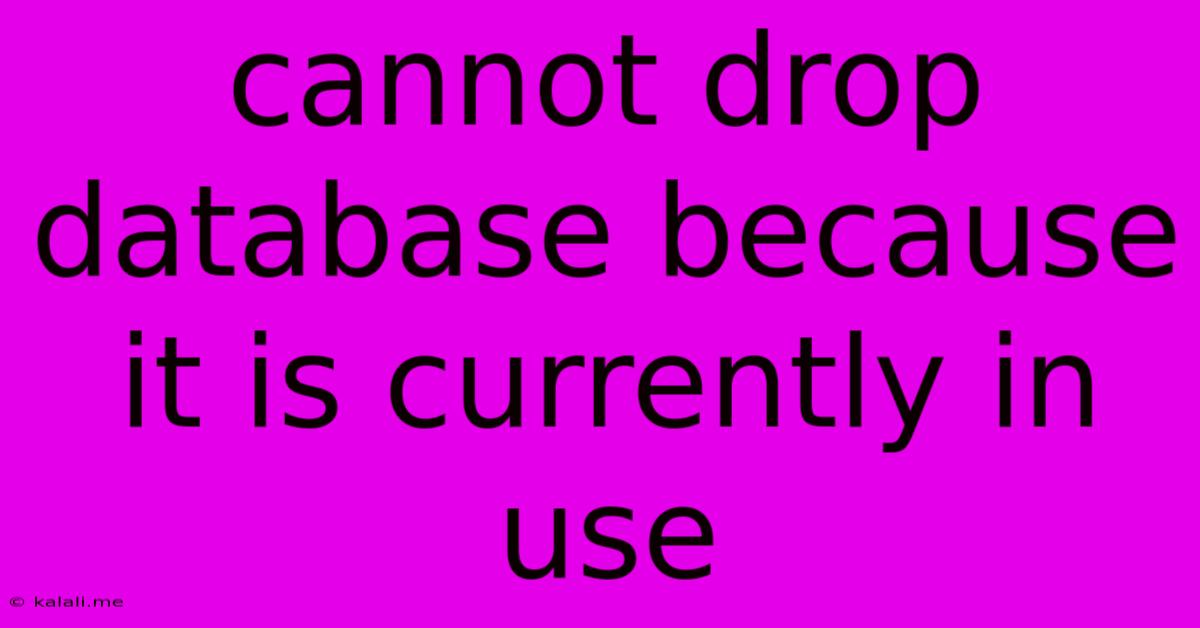Cannot Drop Database Because It Is Currently In Use
Kalali
May 25, 2025 · 3 min read

Table of Contents
Cannot Drop Database: Troubleshooting the "Currently in Use" Error
The dreaded "cannot drop database because it is currently in use" error is a common headache for database administrators and developers. This comprehensive guide will walk you through the most common causes of this issue and provide effective troubleshooting steps to get your database dropped successfully. Understanding the underlying reasons is key to preventing this problem in the future.
Why is my database in use? This error message indicates that one or more processes are actively connected to the database you're trying to delete. These processes could range from active applications utilizing the database for read/write operations to background processes performing maintenance tasks.
Common Causes and Troubleshooting Steps
Here's a breakdown of the most frequent reasons behind this error, coupled with practical solutions:
1. Active Connections: This is the most prevalent cause. Applications, scripts, or even your database management tool itself might still be connected.
- Identify Active Connections: Use your database system's monitoring tools to identify all active connections. The specific commands vary depending on your database system (MySQL, PostgreSQL, SQL Server, etc.). Look for commands that list active sessions or connections.
- Terminate Connections: Once you've identified the active connections, terminate them gracefully. Again, the commands differ based on your database system. Carefully review the documentation for your specific system. Avoid forcefully killing connections unless absolutely necessary, as this can lead to data corruption.
- Restart Services (Last Resort): If you can't identify or terminate connections through the normal means, restarting the database service might disconnect all active sessions. Remember to back up your data before attempting this.
2. Background Processes: Scheduled tasks, maintenance jobs, or replication processes might be using the database.
- Check Scheduled Tasks: Review your database's scheduled tasks or jobs. Pause or disable any tasks that might be accessing the target database.
- Replication: If you're using database replication, ensure that the replication process is paused or stopped before attempting to drop the database.
3. Locked Objects: Sometimes, specific database objects (tables, views, stored procedures) might be locked, preventing the database from being dropped.
- Check for Locked Objects: Utilize your database system's tools to identify any locked objects. The exact commands vary greatly across different systems.
- Unlock Objects: Try to unlock the identified objects. This might involve identifying the process holding the lock and terminating it, or waiting for the lock to be released naturally.
4. Database Transaction Issues: An incomplete or uncommitted transaction can prevent a database from being dropped.
- Check Transaction Logs: Examine your database's transaction logs to identify any ongoing transactions. If necessary, rollback or commit these transactions.
5. Incorrect Permissions: You may not have the necessary permissions to drop the database.
- Verify Permissions: Confirm that your user account has the required privileges (typically
DROP DATABASEpermission) to execute theDROP DATABASEcommand.
Prevention Strategies
Preventing this error is often easier than resolving it. Here are some proactive measures:
- Proper Application Design: Design applications to gracefully handle database disconnections.
- Regular Maintenance: Regularly review and clean up inactive connections and scheduled tasks.
- Version Control: Use version control for database schema changes to facilitate rollback if necessary.
- Thorough Testing: Thoroughly test any changes to your database before deploying them to a production environment.
By understanding the root causes of the "cannot drop database because it is currently in use" error and implementing the troubleshooting steps outlined above, you can effectively resolve this issue and prevent it from occurring in the future. Remember to always prioritize data safety and follow best practices for database management.
Latest Posts
Latest Posts
-
How Do I Send An Evite Reminder
Jul 15, 2025
-
When Performing A Self Rescue When Should You Swim To Shore
Jul 15, 2025
-
How Many Decaliters Are In A Liter
Jul 15, 2025
-
What Note Sits In The Middle Of The Grand Staff
Jul 15, 2025
-
Did Lynette Shave Her Head In Real Life
Jul 15, 2025
Related Post
Thank you for visiting our website which covers about Cannot Drop Database Because It Is Currently In Use . We hope the information provided has been useful to you. Feel free to contact us if you have any questions or need further assistance. See you next time and don't miss to bookmark.